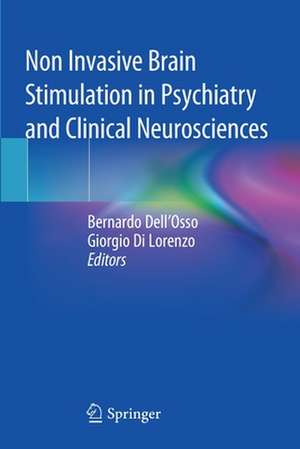Non Invasive Brain Stimulation in Psychiatry and Clinical Neurosciences
Editat de Bernardo Dell'Osso, Giorgio Di Lorenzoen Limba Engleză Paperback – 2 aug 2021
The book is ultimately intended to offer a unique, integrated approach to the use of non-invasive brain stimulation across the clinical neurosciences, providing a comprehensive and updated perspective that will benefit psychiatrists, neurologists, clinical psychologists and neurophysiologists alike.
| Toate formatele și edițiile | Preț | Express |
|---|---|---|
| Paperback (1) | 659.46 lei 43-57 zile | |
| Springer International Publishing – 2 aug 2021 | 659.46 lei 43-57 zile | |
| Hardback (1) | 854.63 lei 43-57 zile | |
| Springer International Publishing – aug 2020 | 854.63 lei 43-57 zile |
Preț: 659.46 lei
Preț vechi: 694.18 lei
-5% Nou
Puncte Express: 989
Preț estimativ în valută:
126.18€ • 132.10$ • 104.41£
126.18€ • 132.10$ • 104.41£
Carte tipărită la comandă
Livrare economică 07-21 aprilie
Preluare comenzi: 021 569.72.76
Specificații
ISBN-13: 9783030433581
ISBN-10: 3030433587
Pagini: 370
Ilustrații: XIII, 370 p. 21 illus., 18 illus. in color.
Dimensiuni: 155 x 235 mm
Greutate: 0.59 kg
Ediția:1st ed. 2020
Editura: Springer International Publishing
Colecția Springer
Locul publicării:Cham, Switzerland
ISBN-10: 3030433587
Pagini: 370
Ilustrații: XIII, 370 p. 21 illus., 18 illus. in color.
Dimensiuni: 155 x 235 mm
Greutate: 0.59 kg
Ediția:1st ed. 2020
Editura: Springer International Publishing
Colecția Springer
Locul publicării:Cham, Switzerland
Cuprins
Foreword. Preface.- SECTION 1: Introducing NIBS: from research to clinical practice: Neurophysiological bases and mechanisms of action of Transcranial Magnetic Stimulation. Neurophysiological bases and mechanisms of action of Transcranial Direct Current Stimulation. Safety and guidelines recommendations of NIBS interventions. The role of transcranial brain stimulation in integrative neuroscience. NIBS as a research tool in clinical and translational neuroscience.- SECTION 2: TMS and its applications in neuropsychiatry and clinical neuroscience: Depressive Disorders. TMS in Psychotic Disorders. TMS in Obsessive Compulsive Disorder. TMS in ADHD and Impulse Control Disorders. Use of TMS in neurodevelopmental and motor disorders. Use of TMS in addiction. Use of TMS in Dementia. TMS applications in patients with Anxiety Disorders. Transcranial Magnetic Stimulation for cognitive neuroscience. Applications and open questions. TMS combined with EEG to study psychiatric and neurological disorders.- SECTION 3: tDCS and its applications in neuropsychiatry and clinical neuroscience: tDCS in Depressive Disorders. tDCS in Psychotic Disorders. tDCS in Obsessive Compulsive Disorder. tDCS in addiction. The use of tDCS in neurodevelopmental and motor disorders. tDCS in Anxiety Disorders. The use of tES in dementia: from pathophysiology to treatment. Neuropsychological, emotional and cognitive investigations with tDCS. Research perspectives of tES in clinical neurosciences. Conclusions.
Notă biografică
Bernardo Dell’Osso is currently Associate Professor of Psychiatry at the University of Milan, Italy, and Director of the UOC Psychiatry of the Ospedale Sacco-Polo Universitario, ASST Fatebenefratelli-Sacco, Milan, Italy. He received his medical degree from the University of Milan. He trained first at the Department of Psychiatry, University of Pisa, Italy, and subsequently at the Mount Sinai School of Medicine, New York, USA. He also completed a clinical fellowship in Transcranial Magnetic Stimulation at the department of Biological Psychiatry, Columbia University New York, USA. Since 2014 he has been Scientific Advisor at the Department of Psychiatry and Behavioral Sciences, Bipolar Disorders Clinic, Stanford University, CA, USA. Prof. Dell’Osso’s research interests focus on neuropsychobiology, neurochemistry, genetics and epigenetics of mood and anxiety disorders, neuropsychopharmacological treatments, neuromodulation, and impulse control disorders. He is a member of several national and international scientific societies and serves on the editorial board of various international peer-reviewed journals, among them CNS Spectrums, Comprehensive Psychiatry and International Journal of Bipolar Disorders. He has authored or co-authored more than 200 scientific papers published in national and international journals, and 5 monographs.
Giorgio Di Lorenzo is currently Associate Professor at the Chair of Psychiatry, Department of Systems Medicine, University of Rome Tor Vergata, Italy. He received his medical degree from the University of Rome Tor Vergata, Italy, where he also completed his training as psychiatrist and subsequently earned a PhD in Neurosciences. His research interests include: cognitive neuroscience, neurobiology and brain physiology, neurophysiology, electrophysiology, functional neuroimaging, biological psychiatry, psychophysiology, neuromodulation, and electroencephalography. He is the author of more than 100 papers inpeer-reviewed international journals.
Giorgio Di Lorenzo is currently Associate Professor at the Chair of Psychiatry, Department of Systems Medicine, University of Rome Tor Vergata, Italy. He received his medical degree from the University of Rome Tor Vergata, Italy, where he also completed his training as psychiatrist and subsequently earned a PhD in Neurosciences. His research interests include: cognitive neuroscience, neurobiology and brain physiology, neurophysiology, electrophysiology, functional neuroimaging, biological psychiatry, psychophysiology, neuromodulation, and electroencephalography. He is the author of more than 100 papers inpeer-reviewed international journals.
Textul de pe ultima copertă
This book presents the state of the art regarding the use of non-invasive brain stimulation (TMS and tDCS) in the research and treatment of neuropsychiatric disorders. The contributions, all of which were prepared by internationally recognized experts in the field, are divided into two main sections (for TMS and tDCS, respectively) across diagnoses, following an introductory section on the mechanisms of action and neurophysiological background. Neuropsychological perspectives and approaches are provided as well.
The book is ultimately intended to offer a unique, integrated approach to the use of non-invasive brain stimulation across the clinical neurosciences, providing a comprehensive and updated perspective that will benefit psychiatrists, neurologists, clinical psychologists and neurophysiologists alike.
Caracteristici
Offers an integrated approach to the use of TMS and tDCS Presents current clinical applications and outlines future research directions Written and edited by leading experts in the field
